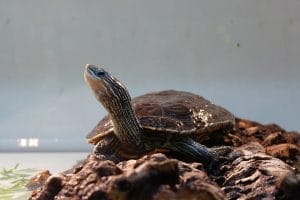Mauremys leprosa (Spanish pond turtle)
Home > Turtle Database > Mauremys leprosa (Spanish pond turtle)

Mauremys leprosa, commonly known as the Spanish pond turtle, is a freshwater turtle species native to the Iberian Peninsula. Known for its adaptability to various aquatic environments, this turtle plays a crucial role in its ecosystem. Despite facing several threats, conservation efforts are in place to ensure its survival.
Native To These Regions
Alentejo (Portugal), Algarve (Portugal), Algeria, Andalusia (Spain), Aragon (Spain), Balearic Islands (Spain), Canary Islands (Spain), Castilla y León (Spain), Castilla-La Mancha (Spain), Catalonia (Spain), Ceuta (Spain), Extremadura (Spain), Gambia, Libya, Lisbon (Portugal), Madrid (Spain), Mauritania, Melilla (Spain), Morocco, Murcia (Spain), Senegal, Tunisia, Valencia (Spain), Western SaharaNative Turtle Species Map – Find Turtles by Region
Scientific Classification
- Kingdom: Animalia
- Phylum: Chordata
- Class: Reptilia
- Order: Testudines
- Family: Geoemydidae
- Genus: Mauremys
- Species: Mauremys leprosa
Common Names
- Spanish pond turtle
- Iberian pond turtle
- Leprosa turtle
This Hilarious Turtle Book Might Know Your Pet Better Than You Do
Let’s be real—most turtle care guides feel like reading a textbook written by a sleep-deprived zookeeper.
This one’s not that.
Told from the snarky point of view of a grumpy, judgmental turtle, 21 Turtle Truths You’ll Never Read in a Care Guide is packed with sarcasm, sass, and surprisingly useful insights.
And hey—you don’t have to commit to the whole thing just yet.
Grab 2 free truths from the ebook and get a taste of what your turtle really thinks about your setup, your food choices, and that weird plastic palm tree.
It’s funny, it’s honest, and if you’ve ever owned a turtle who glares at you like you’re the problem—you’ll feel seen.
Identification
Description
Mauremys leprosa has a moderately domed carapace that ranges in color from olive to brown, often featuring dark markings or patterns. The plastron is yellowish with distinct markings, and the limbs are webbed, aiding in swimming. Adults typically reach a carapace length of 15-20 centimeters.
Sexual Dimorphism
Males can be distinguished by their longer tails and more concave plastron compared to females. Females generally have a broader and flatter plastron to accommodate egg-laying.
Check more turtles from the Mauremys genus
Native Origin and Distribution
Geographical Range
This species is primarily found in the Iberian Peninsula, including parts of Spain and Portugal. Its distribution extends to various freshwater habitats within these regions.
Preferred Habitat
Mauremys leprosa thrives in slow-moving or stagnant freshwater bodies such as ponds, marshes, and slow-flowing rivers. It prefers areas with abundant vegetation, which provide shelter and foraging opportunities.
Behavior
Feeding Habits
The Spanish pond turtle is omnivorous, feeding on a diet that includes aquatic vegetation, insects, small invertebrates, and carrion. It forages both in water and on land, depending on the availability of food sources.
Predators
Natural predators of Mauremys leprosa include birds of prey, larger fish, and mammals such as foxes and raccoons. Juveniles are particularly vulnerable to predation.
Reproduction
Breeding Season
The breeding season typically occurs in the spring and early summer when temperatures rise, triggering mating behaviors and nesting activities.
Reproductive Method
Females lay eggs in sandy or soft soil near water bodies. A clutch usually consists of 3-10 eggs, which are buried to incubate. The incubation period varies with temperature but generally lasts several weeks before hatchlings emerge.
Conservation
Extinction Status
Mauremys leprosa is currently listed as Vulnerable on the IUCN Red List, indicating that it faces risks that could lead to its endangerment if not addressed.
Threats
Key threats include habitat destruction due to urbanization and agricultural expansion, pollution of freshwater habitats, collection for the pet trade, and competition with invasive species.
Conservation Measures
Conservation efforts focus on habitat protection and restoration, regulating collection and trade, and implementing breeding programs. Protected areas and environmental regulations are essential in safeguarding their natural habitats.
Economic Importance
While not a major economic resource, Mauremys leprosa contributes to local ecosystems by controlling insect populations and maintaining aquatic vegetation balance. Additionally, it holds value in eco-tourism and educational programs focused on biodiversity and conservation.
Interesting Facts
- Mauremys leprosa has a remarkable ability to adapt to various water conditions, including temporary ponds that dry up seasonally.
- This species exhibits temperature-dependent sex determination, where the incubation temperature of eggs influences the sex of the hatchlings.
- They can live for several decades in the wild, with some individuals reaching over 30 years of age.
- The Spanish pond turtle plays a role in traditional folklore and is often featured in local cultural narratives.

About Author
Muntaseer Rahman started keeping pet turtles back in 2013. He also owns the largest Turtle & Tortoise Facebook community in Bangladesh. These days he is mostly active on Facebook.














